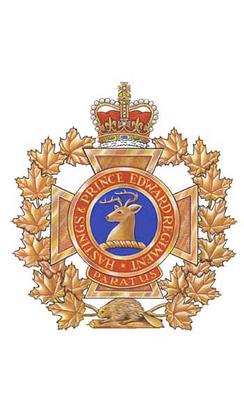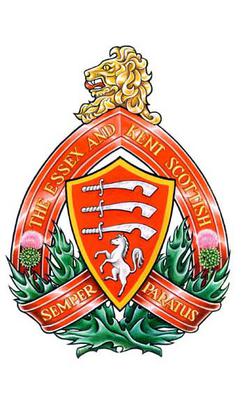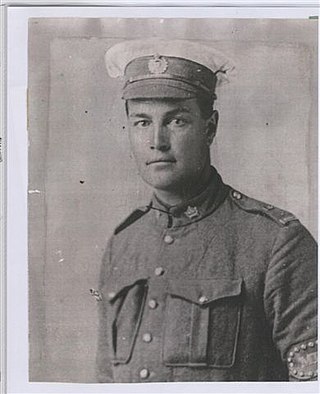Related Research Articles

The Royal Hamilton Light Infantry (Wentworth Regiment) (RHLI) is a Primary Reserve infantry regiment of the Canadian Army, based at John Weir Foote VC Armoury in Hamilton, Ontario. The RHLI is part of 31 Canadian Brigade Group, which is part of 4th Canadian Division.

The Ontario Regiment (RCAC) is a Primary Reserve armoured reconnaissance regiment of the Canadian Army. The unit is based in downtown Oshawa, Ontario, and is named after Ontario County (1852–1973). Formed in 1866, and more commonly known as the 'Ontarios', 'black cats' or 'ONT R' (pronounced "ON-tar"), the regiment ranks among the oldest continuously serving Reserve (Militia) regiments in Canada and is one of the senior armoured regiments in the Royal Canadian Armoured Corps.

The Hastings and Prince Edward Regiment is a Primary Reserve infantry regiment of the Canadian Army. The regiment is part of 33 Canadian Brigade Group, one of four brigade groups of 4th Canadian Division. The regimental headquarters and one company are at 187 Pinnacle Street in Belleville and on Willmott Street in Cobourg, with another rifle company in Peterborough. The Peterborough Armoury houses what was traditionally B Company or Moro Company. Moro Company also serves as the headquarters for the regiment’s Assault Pioneer Platoon. Normally, the regiment deploys as a composite, Ortona Company, while the headquarters and administration form Somme Company.

The Essex and Kent Scottish is a Primary Reserve infantry regiment of the Canadian Army.
The 120th Battalion, CEF was a unit in the Canadian Expeditionary Force during the First World War. Based in Hamilton, Ontario, the unit began recruiting in late 1915 in that city and parts of Wentworth County. After sailing to England in August 1916, the battalion was absorbed into the 2nd Reserve Battalion, CEF on January 20, 1917. The 120th Battalion, CEF had one Officer Commanding: Lieut-Col. George Douglas Fearman.
The 125th Battalion, CEF was a unit in the Canadian Expeditionary Force during the First World War.
The 126th Battalion (Peel), CEF was a unit in the Canadian Expeditionary Force during the First World War. Based in Toronto, Ontario, the unit began recruiting in late 1915 in Peel County. After sailing to England in August 1916, the battalion was absorbed into the 109th and 116th Battalions, CEF, and the 8th Reserve Battalion on October 13, 1916. The 126th Battalion (Peel), CEF, had one Officer Commanding: Lieut-Col. F. J. Hamilton.
The 129th (Wentworth) Battalion, CEF was a unit in the Canadian Expeditionary Force during the First World War. Based in Dundas, Ontario, the unit began recruiting in late 1915 in Wentworth County. After sailing to England in August 1916, the battalion was absorbed into the 123rd and 124th Battalions, CEF and the 12th Reserve Battalion in October 1916. The 129th (Wentworth) Battalion, CEF had one Officer Commanding: Lieut-Col. W. E. S. Knowles.

The 130th Battalion, CEF was a unit in the Canadian Expeditionary Force during the First World War. Based in Perth, Ontario, the unit began recruiting in late 1915 in Lanark and Renfrew Counties. After sailing to England in September 1916, the battalion was absorbed into the 12th Reserve Battalion on October 6, 1916. The 130th Battalion, CEF had one Officer Commanding: Lieut-Col. J. E. de Hertel.

The 133rd Battalion, CEF was a unit in the Canadian Expeditionary Force during the First World War.
The 135th (Middlesex) Battalion, CEF was a unit in the Canadian Expeditionary Force during the First World War. Based in London, Ontario, the unit began recruiting in late 1915 in Middlesex County. After sailing to England in August 1916, the battalion was absorbed into the 116th, 125th and 134th Battalions as well as the 8th Reserve Battalion in October 1916. The 135th (Middlesex) Battalion, CEF had one Officer Commanding: Lieut-Col. B. Robson.
The 139th (Northumberland) Battalion, CEF was a unit in the Canadian Expeditionary Force during the First World War. Based in Cobourg, Ontario, the unit began recruiting in late 1915 in Northumberland County. After sailing to England in September 1916, the battalion was absorbed into the 3rd and 36th Reserve Battalions on October 6, 1916. The 139th Battalion, CEF had one Officer Commanding: Lieut-Col. W. H. Floyd.
The 155th (Quinte) Battalion, CEF was a unit in the Canadian Expeditionary Force during the First World War. Based in Barriefield, Ontario, the unit began recruiting in late 1915 in Hastings and Prince Edward Counties. After sailing to England in October 1916, the battalion was absorbed into the 154th Battalion, CEF and 6th Reserve Battalion on December 8, 1916. The 155th (Quinte) Battalion, CEF had one Officer Commanding: Lieut-Col. M. K. Adams.
The 156th Battalion, CEF was a unit in the Canadian Expeditionary Force during the First World War.
The 161st (Huron) Battalion, CEF was a unit in the Canadian Expeditionary Force during the First World War. Based in London, Ontario, the unit began recruiting in late 1915 in Huron County. After sailing to England in November 1916, the battalion was absorbed into the 4th Reserve Battalion on February 15, 1918.
The 235th Battalion, CEF was a unit in the Canadian Expeditionary Force during the First World War. Based in Bowmanville, Ontario, the unit began recruiting in the Spring of 1916 in Northumberland and Durham Counties. After sailing to England in May 1917, the battalion was absorbed into the 3rd Reserve Battalion on May 14, 1917. The 235th Battalion, CEF had one Officer Commanding: Lieut-Col. S. B. Scobell.
The Peel and Dufferin Regiment was an infantry regiment of the Non-Permanent Active Militia of the Canadian Militia. First organized in 1866 as the 36th Peel Battalion of Infantry, the regiment was reorganized in 1900 as the 36th Peel Regiment. Following the First World War, the regiment was reorganized again in 1920 as The Peel Regiment and for the final time in 1923 as The Peel and Dufferin Regiment. In 1936, the regiment was Amalgamated with The Lorne Rifles (Scottish) to form The Lorne Scots.
The Durham Regiment was an infantry regiment of the Non-Permanent Active Militia of the Canadian Militia. In 1936, the regiment was Amalgamated with The Northumberland Regiment to form The Midland Regiment.
The Argyll Light Infantry was an infantry regiment of the Non-Permanent Active Militia of the Canadian Militia. In 1936, the regiment was converted from infantry to form one of the Canadian Army's first tank units, and then in 1946 was converted to anti-tank artillery. In 1954, the regiment was converted back to infantry and amalgamated along with The Midland Regiment into The Hastings and Prince Edward Regiment.
The Midland Regiment was an infantry regiment of the Non-Permanent Active Militia of the Canadian Militia and later the Canadian Army. The regiment was formed in 1936 by the Amalgamation of The Northumberland Regiment and The Durham Regiment. In 1954, The Midland Regiment was amalgamated into The Hastings and Prince Edward Regiment.
References
- Meek, John F. Over the Top! The Canadian Infantry in the First World War. Orangeville, Ont.: The Author, 1971.